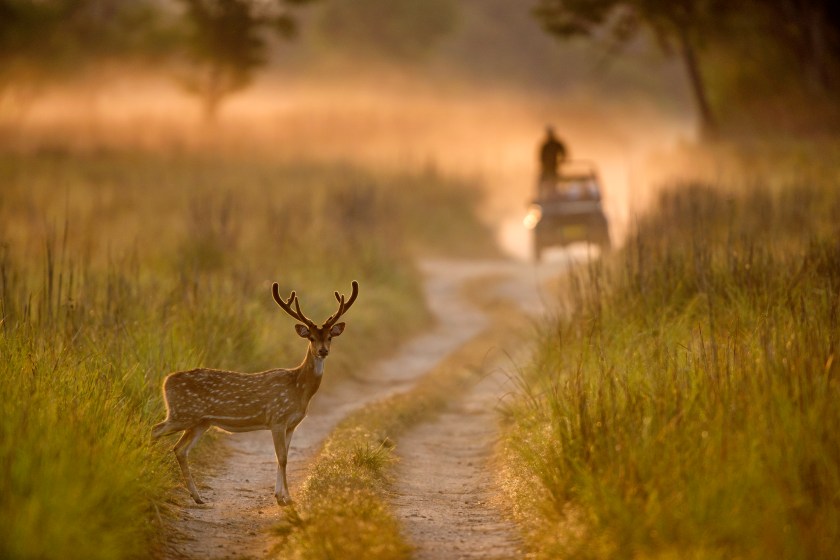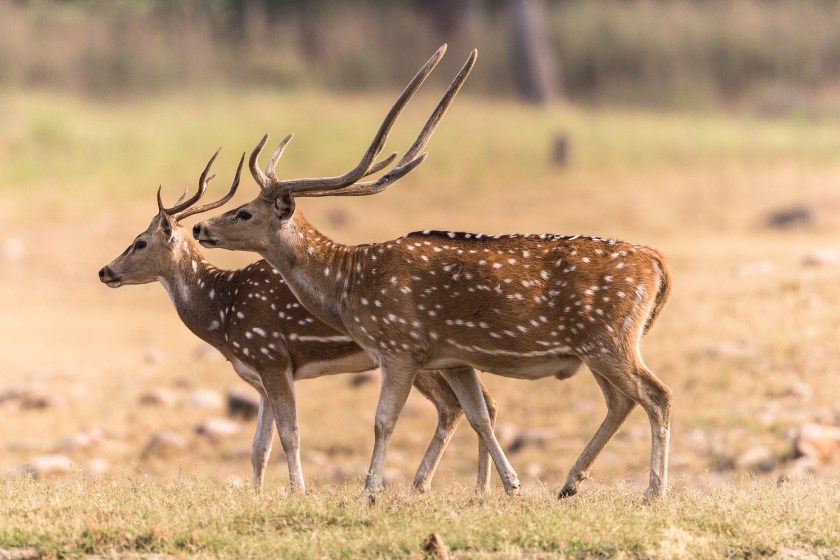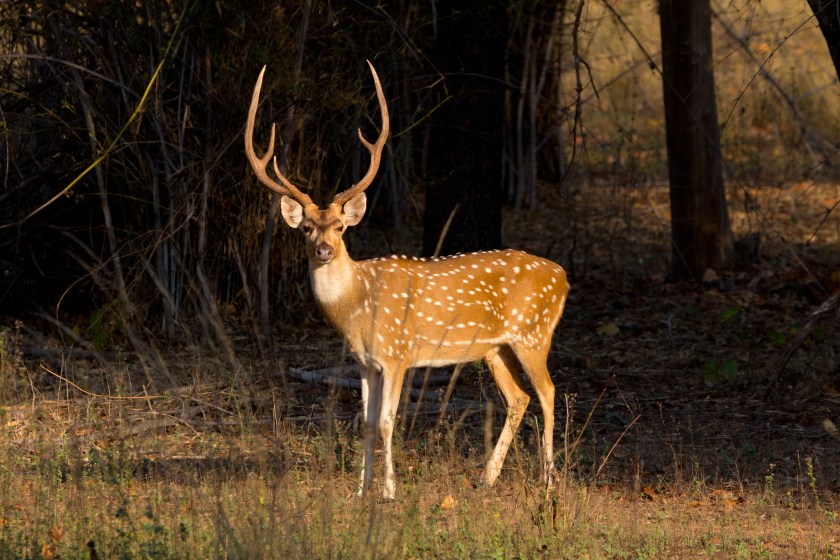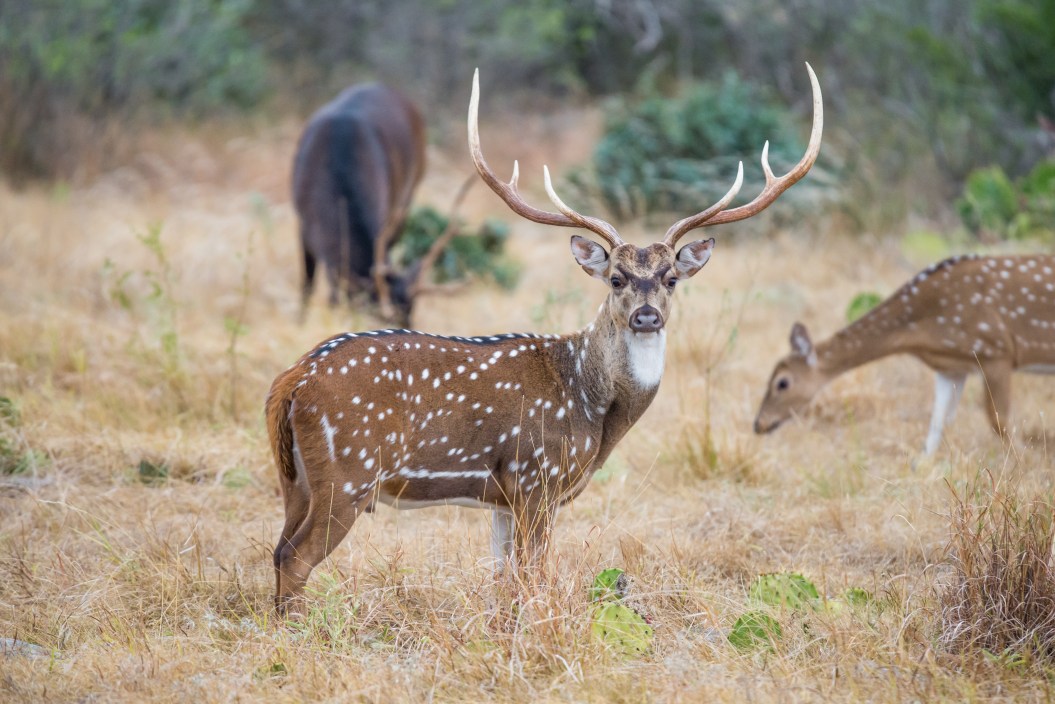The axis deer, also known as the chital deer, is regarded as one of the most beautiful species of deer. Originally native to the Indian subcontinent, they were introduced to Hawaii in the 1890s and Texas in the 1930s. They were also introduced to Australia.
However, they're considered an invasive species, legally in the same category as feral hogs. Despite being invasive, an axis deer hunt is often a bucket-list item for hunters because of the deer's beautiful antlers and the challenge of bagging one.
What are Axis Deer?

Getty Images, GizmoPhoto
Axis deer (scientific names: Cervis axis or Axis axis) sport an orange coat dotted with white spots, similar to that of a fawn of a whitetail deer. Axis deer also have a dark stripe down their spine and white patches on their throats. They're classified under the Cervidae family, bearing resemblance to a number of other deer species such as the fallow deer. Axis deer males grow massive antlers, usually with three to six points with brow tines, and can weigh up to 250 pounds. Adult females are usually a bit smaller.
Similar to the elk, these spotted deer are also extremely vocal, letting out distinctive, sharp alarm calls to communicate. Female axis deer and juveniles bellow and bark, and male axis deer are even known to bugle during the mating season.
The gestation period for axis deer is around 220 days and breeding can occur year-round. It isn't uncommon for an axis to give birth twice in one year, giving them an obvious advantage over native deer species, which only give birth once a year.
Full-grown axis deer are generally bigger than whitetail deer, being slightly taller and with a longer body length. Many people may mistake them for a European species like red deer, or an Australian species like rusa, sambar, or hog deer.
How Did Axis Deer Get to the U.S.?
Originally from the Indian subcontinent, specifically southern India, Nepal, Bhutan, and Sri Lanka, the axis deer was introduced to Molokai, Hawaii in the 1860s as a gift to to King Kamehameha V, then king of Hawaii. They were also brought to Texas in 1932 and Maui in 1959 and can also be found in California. The axis deer was intended as a game animal, and the deer were restricted to farms and controlled hunting sites.
At first, this plan worked out well, with axis deer providing ample meat and beautiful antlers with large tines to anyone who could bag one. Of course, as often happens with animals in captivity, many axis deer eventually escaped to run wild around in Texas and Hawaii. While the vast majority of axis deer remain in captivity, over 6,000 of them now roam freely, taking advantage of the warm weather and ample grasses similar to their native land.
Axis deer can be hunted in Texas and Hawaii, and wildlife officials in both states are attempting to control the population. This is particularly difficult in Hawaii, where these long-lived Cervidae, with a lifespan of 9 to 13 years, have no natural predators.
The Impact of Invasive Axis Deer

Getty Images, sabirmallick
Though not known to be an aggressive species, the primary threat of the axis deer lies in the fact that, as large as Texas is, there simply aren't enough open areas for two thriving species of large deer, the axis and the whitetail deer, to live. On the Hawaiian Islands, the problem of adequate habitat is exacerbated by the smallness of the islands themselves.
The axis and the whitetail must compete for resources in Texas. In Hawaii, the axis strip the landscape of native plants, preventing the regrowth of other forest species and causing food scarcity in the deer populations. This can put extra pressure on other species during drought years when there isn't enough food to go around. Axis deer also compete with local farmers and livestock, and farmers have to work even harder to protect their grazing lands and crops from these larger, bolder foragers.
The axis deer is also very hardy, which is likely one reason they were introduced in the first place. While one might expect a foreign species to succumb easily to diseases in a new environment, axis deer do not. In fact, they're more resistant to outbreaks so while whitetail populations are often culled by disease, the axis populations continue to grow.
As is common with invasive species, the axis deer also have few natural predators. While coyotes and bobcats in Texas will go after them, it's not nearly enough to keep the invasive species in check.
Managing Axis Deer Populations Through Hunting

Getty Images, sabirmallick
Good news: The best way to manage the axis deer is also the simplest. Because they're invasive, the conservation status of axis deer is of "least concern." That means, like many overpopulated species, you can hunt axis deer, and with fewer restrictions than on some native animal populations.
In the state of Texas, non-native and exotic game don't have a limited hunting season. So, unlike whitetails, you can bag an axis deer year-round. There's also no possession limit, so you can bring home as many axis deer as you like, so long as you have room in your truck. The only thing you need is a non-game permit from the Texas Parks and Wildlife Department, which differs from the standard state hunting license. You can also hunt axis deer on ranches in Texas, such as at the Ox Hunting Ranch in Uvalde.
In Hawaii, different areas and islands have different axis deer hunting seasons, with some year-round. There are bag limits, as well as some regulations on archery, muzzleloader, and rifle hunts. If you're interested in hunting axis deer in Hawaii, make sure you double-check regulations for whatever island you are on.
As far as wild game meat goes, axis deer venison is just as good if not better than a whitetail of the same size.
How do You Plan an Axis Deer Hunt?

Getty Images, ea-4
Axis deer roam freely across a wide variety of rural landscapes in Texas and Hawaii. However, when it comes to exotic game animals, it is important to remember that they aren't dispersed as evenly as native game. In most of the states that whitetails call home, you mostly just need to find any patch of woods to find a good deer habitat. However, exotic species, because they are not native to a certain habitat, don't have as large of a range.
While it is entirely possible to plan an axis deer hunt yourself, if finding one sounds intimidating, you can hire a guide or pay for a hunt on a ranch where they're kept for that purpose. Fortunately, axis deer hunts aren't horribly expensive compared to many of the other premiere, exotic game animals that ranches host. Most axis deer hunts cost anywhere from $2,500 to $5,000, depending on whether or not you choose to pay for lodging, a guide, or dinners.
If you choose to roll the dice on a self-planned hunt, the most important thing for you to do is find an area that axis deer frequent before investing your time and energy. Tap into local resources, like forums or Facebook, as many people will advertise an axis deer hunting opportunity for a price, especially in Texas. If you've heard of someone having axis deer on their land, ask for a confirmation of current numbers before spending countless hours in a stand.
READ MORE: Best Mule Deer Hunting States for Your Bucket List




